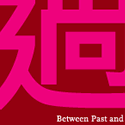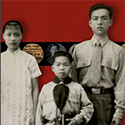|
|
| Show All 24 Results (Text Only) |
|
| Art and China after 1989: Theater of the World |
|
| Guggenheim Museum
|
”Art and China after 1989 presents work by 71 key artists and groups active across China and worldwide whose critical provocations aim to forge reality free from ideology, to establish the individual apart from the collective, and to define contemporary Chinese experience in universal terms. Bracketed by the end of the Cold War in 1989 and the Beijing Olympics in 2008, it surveys the culture of artistic experimentation during a time characterized by the onset of globalization and the rise of a newly powerful China on the world stage. The exhibition’s subtitle, Theater of the World, comes from an installation by the Xiamen-born, Paris-based artist Huang Yong Ping: a cage-like structure housing live reptiles and insects that coexist in a natural cycle of life, an apt spectacle of globalization’s symbiosis and raw contest.” See also: Teaching Materials.
Go to Museum Resource: https://www.guggenheim.org/exhibition/art-and-china-after-1989-theater-of-the-w... | |
|
|
| Art and China's Revolution |
|
| Asia Society
|
"Art and China’s Revolution reflects upon one of the most tumultuous and catastrophic periods in recent Chinese history⎯the three decades following the establishment of the Peoples Republic of China in 1949. During this time, the government led by Mao Zedong sought to modernize China across all aspects of society, a process that included suppressing or destroying much of traditional culture. The government also sought to create a new visual culture to communicate its goals and ideology to the Chinese people. Artists were encouraged to create art that reflected the revolutionary spirit of the time, in Mao’s words, to create art for the people. The impact of this directive on artists and art making was enormous. ... Until now, little effort has been made to take account of this period, during which art and politics were so closely intertwined. ... This exhibition marks a first attempt, which we hope will be the start of many, to examine these artistic developments within an historical framework that prompts a discussion of their impact on Chinese culture today." With extensive text and images of several works from the exhibition, as well as an interactive timeline of Chinese art from 1949 to 1979. Uses Flash.
Go to Museum Resource: http://sites.asiasociety.org/chinarevo/ | |
|
|
|
| Between Past and Future: New Photography and Video from China |
|
| Asia Society
|
Online presentation of a 2004 exhibition that takes "a comprehensive look at the innovative photo and video art produced since the mid-1990s in China." Featured topics: History and Memory; Reimagining the Body; People and Places; and Performing the Self.
Go to Museum Resource: http://sites.asiasociety.org/arts/past_future/index.html | |
|
|
|
| The Chairman Smiles |
|
| International Institute of Social History
|
"The former Soviet Union, Cuba, and China: three countries where posters played an important political role and received a large amount of artistic attention. This is a selection of 145 political posters, famous masterpieces as well as equally beautiful but unknown examples drawn from the collection of the International Institute of Social History in Amsterdam. ... The Chinese posters include not only a number from the period of the Cultural Revolution (1966-1976), with the glorification of Mao Zedong, idyllic scenes in agricultural communes and sharp attacks on political opponents, but also extremely rare posters from circa 1949 to the early 1960s, with the establishment of the People's Republic and the campaign for the Great Leap Forward. There are also posters from the 1980s and early 1990s, the period of Deng Xiaoping and the economic modernization."
Go to Museum Resource: http://www.iisg.nl/exhibitions/chairman/index.php | |
|
|
| Chinese American: Exclusion/Inclusion [PDF] |
|
| Chinese Historical Society of America
|
Curriculum materials to accompany the New York Historical Society 2015 exhibition, “Chinese American: Exclusion/Inclusion” that explores the complex history of Chinese Americans. The exhibition’s title encapsulates the challenges of immigration, citizenship, and belonging that shaped both the Chinese American experience and the development of the United States as a nation.
Go to Museum Resource: https://chsa.org/wp-content/uploads/2016/09/Chinese-American-Classroom-Material... | |
|
|
| Chinese Calligraphy |
|
| The Metropolitan Museum of Art
|
An overview of the development of calligraphy in China: "Calligraphy, or the art of writing, was the visual art form prized above all others in traditional China. The genres of painting and calligraphy emerged simultaneously, sharing identical tools—namely, brush and ink. Yet calligraphy was revered as a fine art long before painting; indeed, it was not until the Song dynasty, when painting became closely allied with calligraphy in aim, form, and technique, that painting shed its status as mere craft and joined the higher ranks of the fine arts. With images of 16 paintings from the Song, Ming, and Qing dynasties and two related objects.
Go to Museum Resource: http://www.metmuseum.org/toah/hd/chcl/hd_chcl.htm | |
|
|
|
| Show All 24 Results (Text Only) |









